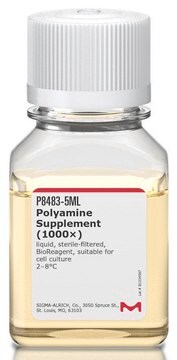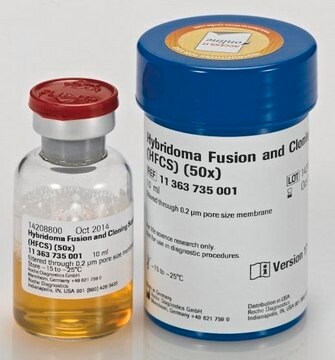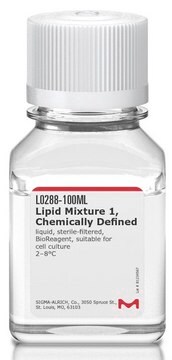S4920
SITE Liquid Media Supplement (100×)
liquid, sterile-filtered, BioReagent, suitable for cell culture
Faça loginpara ver os preços organizacionais e de contrato
About This Item
Código UNSPSC:
12352205
Produtos recomendados
esterilidade
sterile-filtered
Nível de qualidade
linha de produto
BioReagent
Formulário
liquid
técnica(s)
cell culture | mammalian: suitable
Impurezas
endotoxin, tested
Condições de expedição
ambient
temperatura de armazenamento
2-8°C
Categorias relacionadas
Descrição geral
SITE Liquid Media Supplement (100×) serves as a substitute for serum-free formulations. It contains purified factors required for in vitro growth and differentiation studies. The addition of supplements to media will vary, depending on the cell type being studied and the basal medium employed. It is a general cell supplement designed for use in non-complex media (e.g., minimum essential medium (MEM), Roswell Park Memorial Institute Medium (RPMI-1640)) and complex media (e.g., Ham′s F-12, Dulbecco′s Modified Eagle Medium (DME) /F-12, MEM) with sodium pyruvate.
Aplicação
SITE Liquid Media Supplement (100×) has been used:
- in the 3D culture of mouse embryonic pancreatic epithelial cells
- to isolate rabbit gastric glands and parietal cells
- to isolate rabbit single proximal tubule cells
Ações bioquímicas/fisiológicas
- Insulin: a polypeptide hormone that promotes the uptake of glucose and amino acids and may owe an observed mitogenic effect to this property.
- Transferrin: an iron-transport protein. Iron is an essential trace element but can be toxic in its free form. To nourish cells in culture, iron is supplied bound to transferrin in serum.
- Selenium: an essential trace element normally provided by serum.
- Ethanolamine: plays a significant role in the proliferation of hybridoma cells and frequently is added to supplements used for culturing these cells.
Componentes
Contains 1.0mg/ml recombinant human insulin, 0.55mg/ml human transferrin (substantially iron-free), 0.5μg/ml sodium selenite and 0.2mg/ml ethanolamine at the 100x concentration.
Nota de preparo
Prepared in Earle′s Balanced Salt Solution (EBSS) without phenol red.
Código de classe de armazenamento
12 - Non Combustible Liquids
Classe de risco de água (WGK)
WGK 1
Ponto de fulgor (°F)
Not applicable
Ponto de fulgor (°C)
Not applicable
Escolha uma das versões mais recentes:
Já possui este produto?
Encontre a documentação dos produtos que você adquiriu recentemente na biblioteca de documentos.
Os clientes também visualizaram
Lixin Zhu et al.
American journal of physiology. Cell physiology, 295(1), C192-C202 (2008-05-16)
In a comparison of three different tissues, the membrane cytoskeleton linker protein ezrin was found to assume high levels of phosphorylation on threonine-567 (T567) in the brush border membranes of renal proximal tubule cells and small intestine enterocytes, in contrast
Nico Laur et al.
PloS one, 15(5), e0233357-e0233357 (2020-05-21)
Trace elements and minerals are compounds that are essential for the support of a variety of biological functions and play an important role in the formation of and the defense against oxidative stress. Here we describe a technique, allowing sequential
Gisela Wilcox
The Clinical biochemist. Reviews, 26(2), 19-39 (2005-11-10)
As obesity and diabetes reach epidemic proportions in the developed world, the role of insulin resistance and its consequences are gaining prominence. Understanding the role of insulin in wide-ranging physiological processes and the influences on its synthesis and secretion, alongside
H Murakami et al.
Proceedings of the National Academy of Sciences of the United States of America, 79(4), 1158-1162 (1982-02-01)
A serum-free medium supplemented with a few growth factors was devised to grow lymphocyte hybridomas. The medium was developed with the hybridoma line MPC11-BL, a fusion product between a mouse plasmacytoma cell line (MPC11TG70na3) and mouse (BALB/c) spleen cells. In
Huihui Huang et al.
Kidney international, 93(4), 855-870 (2017-12-26)
DNA damage contributes to renal tubular cell death during kidney injury, but how DNA damage in tubular cells is regulated is not fully understood. Lethal (3) malignant brain tumor-like 2 (L3MBTL2), a novel polycomb group protein, has been implicated in
Nossa equipe de cientistas tem experiência em todas as áreas de pesquisa, incluindo Life Sciences, ciência de materiais, síntese química, cromatografia, química analítica e muitas outras.
Entre em contato com a assistência técnica





